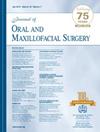Effects of Combined Antiemetic Protocol for the Prevention of Postoperative Nausea and Vomiting in Orthognathic Surgery: A Randomized Double Blinded Clinical Study
IF 2.3
3区 医学
Q2 DENTISTRY, ORAL SURGERY & MEDICINE
引用次数: 0
Abstract
Background
Postoperative nausea and vomiting (PONV) after orthognathic surgery remains one of the most common side effects despite the use of several medications.
Purpose
The study aimed to compare the frequencies of PONV between a combination of metoclopramide with granisetron and granisetron alone.
Study Design, Setting, Sample
A randomized double-blind clinical trial was conducted in 66 consecutive patients who underwent orthognathic surgery at the Department of Oral and Maxillofacial Surgery at Bezmialem Vakif University. Patients with contraindications such as hypersensitivity to medications, gastrointestinal or metabolic disorders, renal insufficiency, electrolyte imbalances, pregnancy, neurological diseases, prolonged QT interval, or mental retardation were excluded.
Predictor Variable
The predictor variable was the antiemetic treatment (combination vs single therapy). Participants were randomized to either the metoclopramide with granisetron group (group GM) or the granisetron-only group (group G).
Main Outcome Variable
The outcome variable was PONV status, measured using the simplified postoperative nausea and vomiting impact scale. The participants were assessed at baseline (when fully awake) and during the subsequent 24 hours.
Covariates
Patient characteristics, total drug doses, systolic and diastolic blood pressure, peripheral arterial oxygen saturation, Apfel’s PONV risk score, total bleeding volume, infused fluid volume, surgery duration, PONV incidence, visual analog scale scores, tramadol requirement, and the use of rescue antiemetics were determined as covariates.
Analyses
Data were analyzed using the Mann–Whitney U test with P value less than.05 considered significant.
Results
The sample consisted of 60 participants, with 30 patients in each treatment group. The mean age was 30 ± 11.6 years in group G and 25.63 ± 10 years in group GM (P = .1); 42% of participants were male (P = .8). PONV scores at the second hour were 1.56 ± 1.45 in group G and 0.79 ± 0.90 in group GM (P = .03). The difference between the groups was statistically significant (P < .001). Participants in group G had a 1.61-fold higher risk of vomiting than those in the group GM (Relative risk = 1.61; 95% CI, 1.313 to 1.962).
Conclusion and Relevance
Compared to granisetron alone, the combination of granisetron and metoclopramide was associated with significant PONV control in patients undergoing orthognathic surgery. A multimodal approach may be adopted to reduce the incidence of PONV in patients undergoing maxillofacial surgery.
联合止吐方案预防正颌手术术后恶心呕吐的效果:一项随机双盲临床研究。
背景:尽管使用了几种药物,但正颌手术后恶心和呕吐(PONV)仍然是最常见的副作用之一。目的:本研究旨在比较甲氧氯普胺联合格拉司琼和单独格拉司琼的PONV频率。研究设计、环境、样本:对在Bezmialem Vakif大学口腔颌面外科连续接受正颌手术的66例患者进行随机双盲临床试验。排除有药物过敏、胃肠或代谢紊乱、肾功能不全、电解质失衡、妊娠、神经系统疾病、QT间期延长或智力低下等禁忌症的患者。预测变量:预测变量为止吐治疗(联合治疗vs单一治疗)。参与者被随机分为甲氧氯普胺联合格拉司琼组(GM组)或格拉司琼组(G组)。主要结局变量:结局变量为PONV状态,使用简化的术后恶心和呕吐影响量表进行测量。参与者在基线(完全清醒时)和随后的24小时内进行评估。协变量:确定患者特征、总药物剂量、收缩压和舒张压、外周动脉血氧饱和度、Apfel's PONV风险评分、总出血量、输注液量、手术时间、PONV发生率、视觉模拟量表评分、曲马多需用量和救急止吐药的使用。分析:数据采用Mann-Whitney U检验,P值小于。0.05认为显著。结果:本组共60例,每组30例。G组平均年龄为30±11.6岁,GM组平均年龄为25.63±10岁(P = 0.1);42%的参与者为男性(P = 0.8)。第2 h时,G组PONV评分为1.56±1.45,GM组为0.79±0.90 (P = 0.03)。结论及相关性:与格拉司琼单用相比,格拉司琼联合甲氧氯普胺可显著控制正颌手术患者的PONV。多模式入路可降低颌面部手术患者PONV的发生率。
本文章由计算机程序翻译,如有差异,请以英文原文为准。
求助全文
约1分钟内获得全文
求助全文
来源期刊

Journal of Oral and Maxillofacial Surgery
医学-牙科与口腔外科
CiteScore
4.00
自引率
5.30%
发文量
0
审稿时长
41 days
期刊介绍:
This monthly journal offers comprehensive coverage of new techniques, important developments and innovative ideas in oral and maxillofacial surgery. Practice-applicable articles help develop the methods used to handle dentoalveolar surgery, facial injuries and deformities, TMJ disorders, oral cancer, jaw reconstruction, anesthesia and analgesia. The journal also includes specifics on new instruments and diagnostic equipment and modern therapeutic drugs and devices. Journal of Oral and Maxillofacial Surgery is recommended for first or priority subscription by the Dental Section of the Medical Library Association.
 求助内容:
求助内容: 应助结果提醒方式:
应助结果提醒方式:


